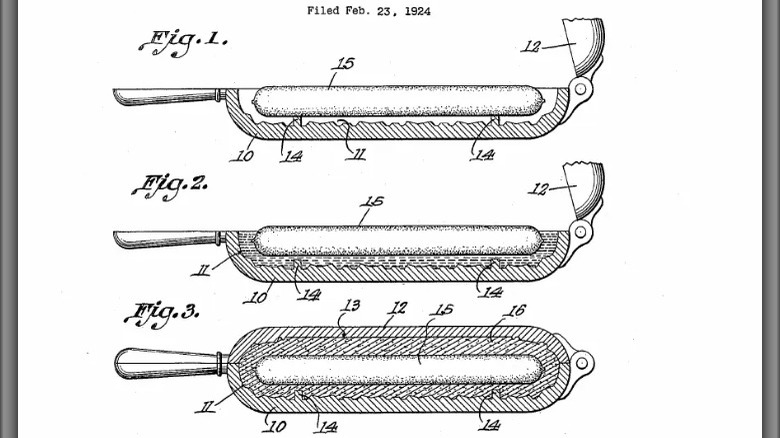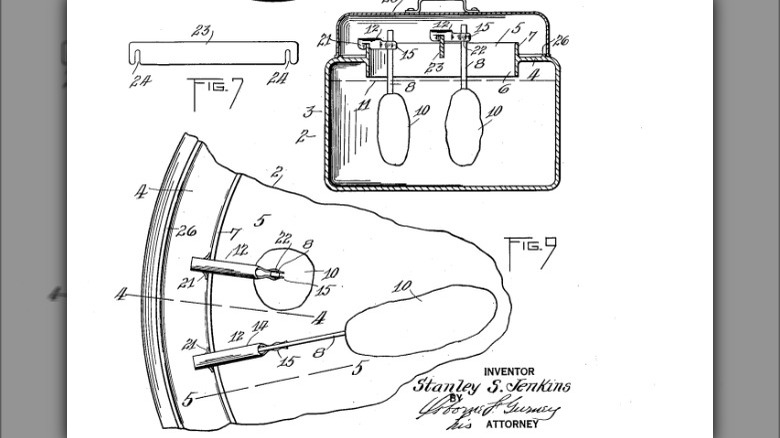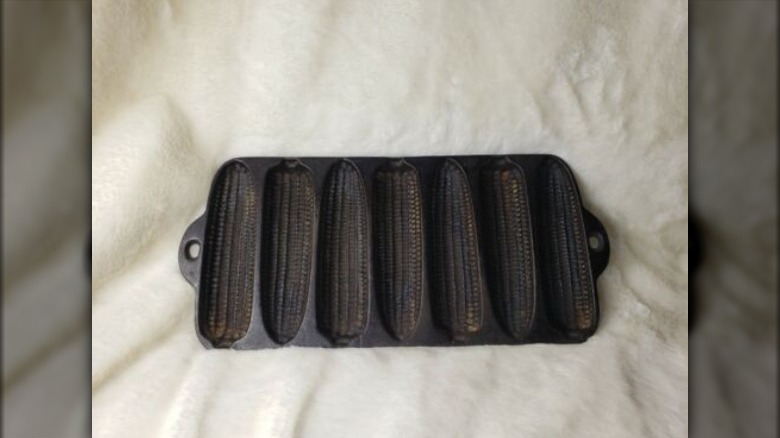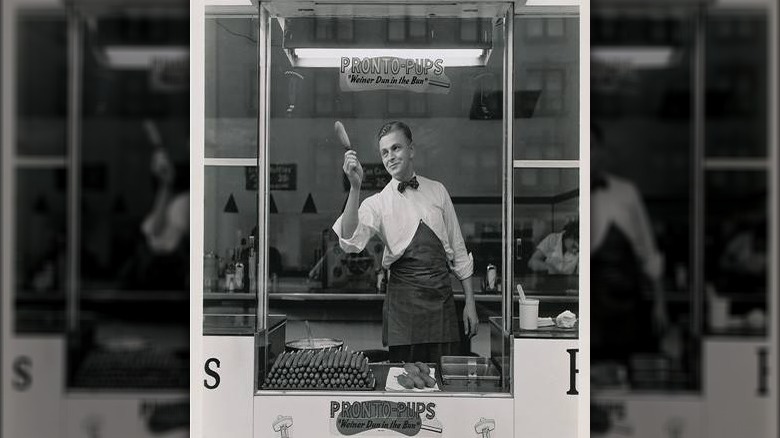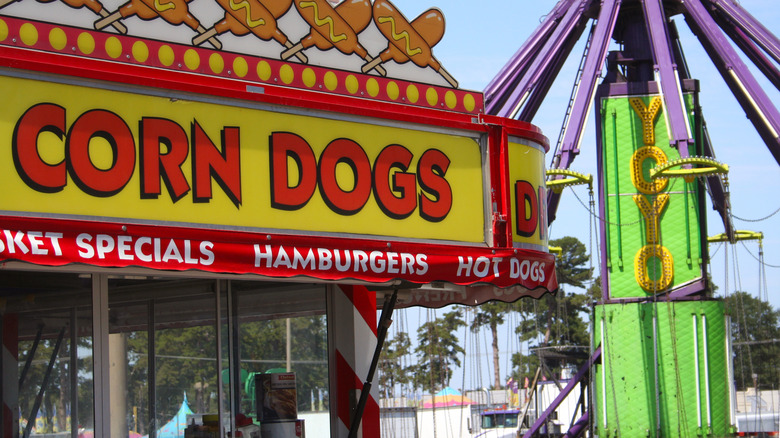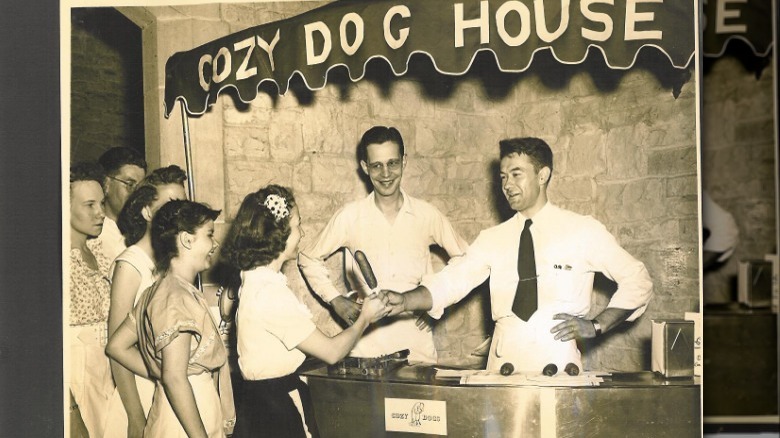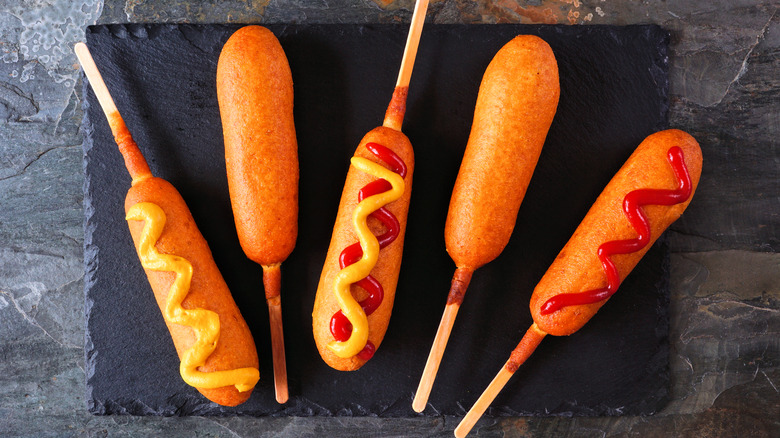The Unexpectedly Mysterious Origins Of The Corn Dog
Corn dogs are relatively simple, even if delicious. This summer fair favorite is a humble food: a hot dog on a stick, covered in a cornbread-like batter and deep fried until golden and crispy on the outside, soft and delicious (and meaty) on the inside.
However, while corndogs themselves are straightforward, their origins aren't so much. People have been fighting over the true origins of corn dogs for years. Do we credit early inventors who made corn dog cooking possible via their unique devices as the OG creators? Or was it the restauranteurs and fair-goers who got creative? If a restauranteur staunchly refuses to call their historic corn dog a corn dog, but they were admittedly the first to fry up a battered hot dog on a stick, do they still get credit?
You're going to have to decide on all of the above for yourself. We're just here to tell the story. These are the unexpectedly mysterious and myriad origins of the corn dog.
A 1924 invention allows cooks to create the first corn dog-adjacent treat
While various eateries around the country will argue that they were the first to serve up the delicious corn dog, there's one thing that you can't argue against: a patent filed with the U.S. government. In February 1924, Francis G. Matson filed a patent with the United States Patent and Trademark Office that details an invention that produces a food item that looks extremely similar to a modern-day corn dog.
Matson's invention summary details a corn dog-like product that's covered in a breading made from a flour and egg batter, and then an extra layer of breadcrumbs. After battering the wiener, it's cooked, and while other methods of creating a similar food existed at the time, Matson claimed that his specific invention and method would prevent the exterior breading from becoming all soggy and gross in the process. The result, Matson goes on to detail, is a perfect product with an improved taste and texture. It could be eaten by hand or with a fork, and it would appeal to both fast food restaurants and kids (the same as corn dogs today).
The only thing missing that makes Matson's invention corn-dog adjacent and not fully a corn dog? The stick.
A 1929 invention put the batter-encased hot dog on a stick
In 1929, we inched ever closer to the modern-day corn dog with an invention that allowed one to easily deep fry items on a stick. The patent for this invention, filed by Stanley S. Jenkins, detailed what he called a "combined dipping, cooking, and article holding apparatus."
In the patent's illustrations, Jenkins shows off what looks very much like a corn dog, being dipped into a vat. Additionally, in the description, Jenkins said he found that wieners, as well as other food items, when placed on sticks, battered, and deep-fried, made for not only a delicious treat but also one that was a little more sanitary (or "clean" and "wholesome," as he describes it), thanks to the stick acting as a handle. His invention makes the cooking process for these foods easier, too, as the user would simply clip the stick onto the device, and then the cooker would take it from there, holding the corn dog (or whatever was being cooked) in place until finished.
In 1929, home cooks could also buy a Krusty Korn Sausage Dog cooker
In 1929, as Stanley Jenkins was working on his apparatus for cooking all things battered, impaled on a stick, and destined for the deep-frier, home cooks could make their own early variants of the corn dog, thanks to the "Krusty Korn Sausage Dog" cooker. Available in wholesale catalogs, the cast iron device could be used on the stovetop or in the oven and allowed you to batter your hot dog before placing it between two cast iron trays, where it cooked until finished. Since it was intended to be used with cornbread batters, the cast iron cooker featured an interior mold that cooked the batter around the hot dog into the shape of an ear of corn.
You can still find the Krusty Korn Sausage Dog cooker for sale today if you're a savvy antique hunter. Some cookers come with a cooking base, while others do not, but all of the original products feature a handle for rotating your dogs as they cooked, to avoid burning.
Unfortunately, this cooker, while producing something similar to a corn dog, is still lacking a few key elements that would make it the true predecessor of the modern treat. There's no stick, for one, and this cooking method is technically baking, not deep-frying.
Many say the true corn dog was invented in the 1930s, in Oregon
For a corn dog that's true to what we expect as a corn dog today, we have to look about a decade past the Krusty Korn Sausage Dog and Stanley Jenkins' frying apparatus, to coastal Oregon. There lies a restaurant where many say that the original, true-to-the-modern-definition corn dog was created.
The story goes that, on Labor Day weekend in 1939, a hot dog stand owner ran into a problem. He had too many buns on his hands and, because he wasn't using all these rolls, they were going stale. He needed a way to serve his customers without over-ordering the buns. His solution? Put a hot dog on a stick, deep fry it in batter, and there you go — the corn dog was invented, no buns needed.
While the hot dog stand owners, George and Vera Boyington, worked on their corn dog recipe for a while before unveiling it to the public, the food quickly caught on and, soon, they began offering franchises.
... But these OG corn dogs weren't called corn dogs
It does seem pretty safe to say that George and Vera Boyington created the very first corn dogs in Oregon in the 1930s — if it weren't for one thing. The Boyingtons didn't call their corn dogs, "corn dogs." The Boyingtons and their successors refer to their creation as a Pronto Pup, the name stemming from the prompt cooking method and the hot dogs used. Some people at the brand, which still exists today, hate the word "corn dog," according to MPR News.
Pronto Pup President Dave Sulmonetti doesn't like to say it, and some franchisee owners even go so far as to simply call corn dogs "the C-D word." The Pronto Pup name was trademarked just a few years after George Boyington came up with the idea, at which point the couple also began franchising, providing franchisees with Pronto Pup batter mix and dictating that franchisees were to never serve the Pronto Pups with ketchup.
Some say the true corn dog creator hails from Texas
As mentioned, there are many different people that could lay claim to the corn dog's creation. Beyond the Boyingtons in Oregon, some swear that the true corn dog originators were actually from Texas. A New York newspaper columnist in 1939 noted that they had eaten a corn dog while visiting Dallas. The columnist referred to it as the local cuisine and gave the item rave reviews. Unlike the case with the Boyingtons, the Texans were actually using the term "corn dogs;" however, despite the correct name, these Texan corn dogs were baked, not fried.
Later articles in the 1940s would also mention the corn dog and its popularity throughout the American South. However, even if the batter-wrapped dog was called a corn dog in Texas, was it really a corn dog, if it wasn't deep-fried? The matter is up for debate.
Texans could've adopted their corn dogs from the Germans
If you believe that the Texans were already eating corn dogs before Oregonians got their first taste of the Pronto Pup, it's worth noting that even they might not have been the original inventors of this batter-wrapped hot dog. Instead, it's possible the large German immigrant population that moved to Texas in the 1800s could have had the idea in the first place. As they attempted to sell their sausage-based eats in the United States, they struggled, so they created a batter-based, fried sausage dish.
It does make sense that the Germans might be to credit for America's current corn dog craze. After all, they were the ones to bring us the first 50% of the corn dog: the hot dog. Rather than Texas German immigrants, it's New York-based German immigrants who are credited with introducing the hot dogs to the city in the late 1800s (though those hot dogs weren't sold with buns at the time; the hot dog bun would come later, in St. Louis).
Yet another potential corn dog inventor can be traced to Illinois
If you don't want to credit Texas or Oregon with corn dogs' origins, you do have other options. Some claim that a roadside stand in Illinois introduced the corn dog in the 1940s. However, much like the case with the Boyingtons and their Pronto Pups, the corn dogs that popped up at Cozy Dog Drive-In on Route 66 weren't actually ever called corn dogs (and still aren't today). Instead, as the restaurant's name suggests, these are Cozy Dogs (founder Ed Waldmire Jr. originally called them Crusty Curs, but that name was very quickly dropped, for obvious reasons).
Much like the Boyingtons, the Waldmires spent a few years perfecting their corn dog-like product before introducing them to the world. Today, they are still at the drive-in, serving the same Cozy Dogs, and they are very adamant that they are, in fact, the inventors of the corn dog.
Corn dogs aren't exclusively American
To muddy the corn dog origin waters just a little bit further, it's worth acknowledging that other countries have their own corn dogs too, just with different names. Could it be that one of these nations can boast a corn dog that predates America?
One of the arguably most popular international corn dog variants is the tokkebi, a Korean corn dog that's a well-known street food and is now a hit on social media. However, this isn't your average corn dog. Instead, it takes the corn dog to new heights. Traditionally, a Korean corn dog would have been made with a sausage on a stick, a thick batter, and a sugar, ketchup, and mustard topping. Now, Korean restaurants are going beyond this, replacing your hot dog filling with ingredients like cheese or yams, and then taking the batter exterior to the next level by coating each corn dog in a range of extra toppings, from diced potatoes to Cheeto dust.
Want to try Korean-style corn dogs for yourself? If you're lucky, you can buy some at Costco.
Whatever you call it, wherever it came from, corn dogs are here to stay
At the end of the day, does it really matter where the corn dog came from or what you call it? This summertime favorite food is here to stay, and there are lots of ways and places to enjoy it, whether you prefer it deep-fried at the state fair, frozen and at-the-ready in your freezer, or purchased from a street food vendor and topped with all sorts of TikTok-ready goodness.
Maybe you don't like corn dogs quite enough to beat the Guinness World Record for most corn dogs eaten in three minutes, which is, as of 2022, 11 corn dogs. And maybe you're not going to make the pilgrimage to a Pronto Pup hot dog stand in Oregon, or the Cozy Dog drive-in outside Springfield, Illinois. But if it's been a while since your last corn dog — maybe it's even been since childhood — head to your nearest Sonic, state fair, or festival, and remember what all the hype is about. Easier yet, make your own corn dogs at home.

